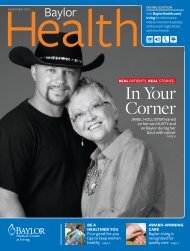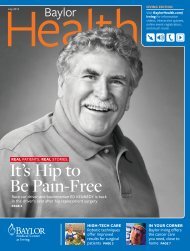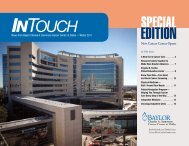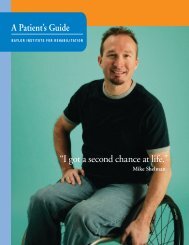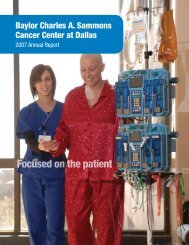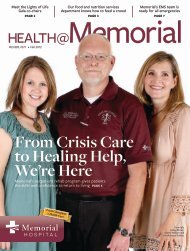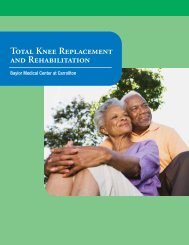Hip Fracture Program - Baylor Health Care System
Hip Fracture Program - Baylor Health Care System
Hip Fracture Program - Baylor Health Care System
- No tags were found...
Create successful ePaper yourself
Turn your PDF publications into a flip-book with our unique Google optimized e-Paper software.
<strong>Hip</strong> <strong>Fracture</strong> <strong>Program</strong>Your complete guide to hip fracture treatment
<strong>Hip</strong> <strong>Fracture</strong> GuidePatient Guide<strong>Hip</strong> <strong>Fracture</strong> Treatment
<strong>Hip</strong> <strong>Fracture</strong> GuideInformationOrthopaedic SurgeonOffice TelephoneInternal Medicine PhysicianOffice TelephoneFollow-up InformationMiscellaneous Notes© 2009 <strong>Baylor</strong> <strong>Health</strong> <strong>Care</strong> <strong>System</strong>. All rights reserved. 3
<strong>Hip</strong> <strong>Fracture</strong> GuideWhat You Will Find in This Patient Guide• Introduction ............................................................... 7• Understanding Your <strong>Hip</strong> and <strong>Hip</strong> <strong>Fracture</strong>s....................................... 9n How your hip worksn What is a hip fracture?n How do hip fractures happen?n How do doctors identify the problem?• Treatment Options. ......................................................... 1 3n This section explains the treatments for hip fractures.• Pelvic <strong>Fracture</strong>s ............................................................. 1 5• Having Orthopaedic Surgery. ................................................. 1 6• What to Expect Following Surgery .............................................. 1 7• Physical/Occupational Therapy. ............................................... 2 1n This section includes discharge and therapy goals, and exercises.• Options for <strong>Care</strong> After Leaving the Hospital. ..................................... 2 4n This section is helpful in understanding the available types of rehabilitation.• Everyday living. ............................................................ 2 5n This section includes instructions for climbing stairs, getting in and out of the car, gettingin and out of a chair, getting in and out of the bathtub, lying in bed, getting in and out ofbed, using the toilet, putting on pants, putting on socks, and putting on shoes.• Guidelines for Preventing Future Falls ........................................... 3 4n This section includes information to help eliminate or reduce factors leading to falls.• Glossary of Hospital Terms.................................................... 3 7n This section is helpful in understanding the different terms used and explanation of facilities.• Notes..................................................................... 4 0© 2009 <strong>Baylor</strong> <strong>Health</strong> <strong>Care</strong> <strong>System</strong>. All rights reserved. 5
<strong>Hip</strong> <strong>Fracture</strong> GuideIntroductionAs the population ages, the number of hip fractures that occur each year rises. A fracture of the hip in anaging adult is not simply a broken bone. It can be a life-threatening illness. Once the fracture occurs, itbrings with it all the potential medical complications that can arise when aging patients are confined toa bed. The complications are what can turn a simple break into a life-threatening illness.At <strong>Baylor</strong> we use a team approach while caring for our patients. You are not just a statistic and will benefitfrom interaction with many different hospital employees. You may be seen by any of the following:• Orthopaedic Surgeon—Performs surgery and directs your care, checks on you while in the hospital,and evaluates you at follow up appointments.• Internal Medicine Physician—He or she will assess and evaluate your medical needs while you are inthe hospital.• Mid Level Providers (Physician Assistants, Nurse Practioners and Registered Nurses)—Assistphysicians with such tasks as taking your medical history, assist during surgery, and evaluate youduring your stay and at follow-up appointments• Anesthesia Team—Administers your anesthesia during surgery, monitors your condition duringsurgery and may help with your pain management after surgery.• <strong>Care</strong> Coordinator/Social Worker—Coordinates your discharge plans between your family, doctor,nursing, and physical therapy. Makes arrangements for continued care after discharge if needed, andinteracts with insurance companies as needed.• Physical Therapy/Occupational Therapy—Teach you exercises to increase your strength, workwith you on an exercise program, instruct you on the correct way to walk and teach you daily livingadjustments, which you may need to temporarily change your lifestyle following surgery.Your daily bedside care will be provided by Registered Nurses and Patient <strong>Care</strong> Assistants.You may also be seen by Lab personnel, Radiology personnel, Respiratory Therapy, and Chaplin Services.Please do not be shy about asking questions and telling someone if you are feeling anxious at any time.Certainly many people will be asking you questions and talking to you about a variety of topics. Yourfeedback helps us plan your treatment and follow up care. Please be thorough when you answer questionsfrom anyone caring for you. All information is strictly confidential.© 2009 <strong>Baylor</strong> <strong>Health</strong> <strong>Care</strong> <strong>System</strong>. All rights reserved. 7
<strong>Hip</strong> <strong>Fracture</strong> GuideUnderstanding <strong>Hip</strong>s and <strong>Hip</strong> <strong>Fracture</strong>sTo further understand how hip fractures happens it is best to understand how the hip works.The hip joint is one of the true ball-and-socket joints of the body. The hip socket is called the acetabulumand forms a deep cup that surrounds the ball of the upper thighbone, or femoral head. The femoralhead is attached to the rest of the femur by a short section of bone called the femoral neck. The bumpon the outside of the femur just below the femoral neck is called the greater trochanter. This is where thelarge muscles of the buttock attach to the femur.A <strong>Health</strong>y hip© 2009 <strong>Baylor</strong> <strong>Health</strong> <strong>Care</strong> <strong>System</strong>. All rights reserved. 9
<strong>Hip</strong> <strong>Fracture</strong> GuideHow do doctors identify the problem?The diagnosis of a hip fracture usually occurs in the emergency room. X-rays are typically used to determineif a hip fracture has occurred and, if so, what type of fracture it is. The orthopaedic surgeon will usethe X-rays to determine if a surgical procedure will be necessary and to decide what type of procedure tosuggest.In a few cases, X-rays may not show the fracture. If the hip continues to hurt and the doctor is suspiciousthat a hip fracture is present a CT scan, sometimes called CAT scan is recommended. This is a noninvasivemedical test that helps physicians diagnose and treat medical conditions. CT imaging combinesspecial X-ray equipment with sophisticated computers to produce multiple images or pictures. Lastly,if needed an MRI may be done. The MRI scanner uses magnetic waves rather than radiation to takemultiple pictures of the hip bones.Tests such as chest X-rays, blood work, and electrocardiograms may be ordered to assess your overallcondition.12 © 2009 <strong>Baylor</strong> <strong>Health</strong> <strong>Care</strong> <strong>System</strong>. All rights reserved.
<strong>Hip</strong> <strong>Fracture</strong> GuideTreatment OptionsThe treatment for a hip fracture begins immediately by making sure you are medically stable. Once thedoctor is sure that you are stable, decisions concerning the treatment of the fracture can be made.Most hip fractures would actually heal without surgery, but the problem is that you would be inbed for eight to twelve weeks. Doctors have learned over the years that placing an aging adult inbed for this period of time has a far greater risk of creating serious complications than the surgeryrequired to fix a broken hip. This is the main reason that surgery is recommended to nearly allpatients with hip fractures.Nearly all hip fractures in the elderly are treated with some type of surgical operation to repair or replacethe fractured bones. The goal of any surgical procedure to treat a fractured hip is to hold the brokenbones securely in position, allowing the patient to get out of bed as soon as possible.Prior to surgery you may be placed in traction. Traction will pull on the injured limb assisting to line upthe bone fragments and provide you comfort before surgery takes place.Many methods have been invented to treat the different types offractures. Most hip fractures are treated in one of the following ways:with metal pins, with a metal plate and screws, metal rod and screws,or replacing the broken femoral head with an artificial implantconsisting of metal and plastic.metal screws1. Metal Screws<strong>Fracture</strong>s that occur through the neck of the femur, ifthey are still in the correct position, may require only twoor three metal pins to hold the two pieces of the fracturetogether. This procedure, called hip pinning, allowspatients to begin putting weight on that leg right aftersurgery.© 2009 <strong>Baylor</strong> <strong>Health</strong> <strong>Care</strong> <strong>System</strong>. All rights reserved. 13
<strong>Hip</strong> <strong>Fracture</strong> Guide2. Metal Plate and ScrewsSome hip fractures occur below the femoral neck in the area called the intertrochanteric region. Thesefractures are called intertronchanteric hip fractures. These hip fractures are usually the result of a fall andoften are the hardest type of fracture to treat. They often involve more than one break. As a result, severalpieces of broken bone must be held together. A combination of a plate on the outside of the bone and alarge screw are used to hold the pieces in place.3. Intramedullary NailA combination of a rod on the inside of the bone and a large screw are used to hold the pieces in place.This procedure allows you to begin putting weight on it right after surgery.4. Artificial Replacement of the Femoral Head (Hemiarthroplasty)When the hip fracture occurs through the neck of the femur and the ball is completely displaced, thereis a very high chance that the blood supply to the femoral head has been damaged. Most surgeons willrecommend removing the femoral head immediately and replacing it with an artificial femoral head madeof metal. This operation is called a hemiarthroplasty. (Hemi means half, and arthroplasty means artificialjoint.) The procedure is called hemiarthroplasty because only half of the joint is replaced. The socket ofthe hip joint is left intact.metal plate and screws intramedullary nail artificial replacement14 © 2009 <strong>Baylor</strong> <strong>Health</strong> <strong>Care</strong> <strong>System</strong>. All rights reserved.
<strong>Hip</strong> <strong>Fracture</strong> GuidePelvic <strong>Fracture</strong>sThe pelvis is a ring-like structure of bones at the lower end of the trunk. The two sides of the pelvis areactually three bones (ilium, ischium, and pubis) that grow together as people age. Strong connectivetissues (ligaments) join the pelvis to the large triangular bone (sacrum) at the base of the spine. Thiscreates a bowl like cavity below the rib cage. On each side, there is a hollow up (acetabulum) that servesas the socket of the hip joint.Unlike hip fractures, most pelvic fractures do not require surgery. They usually heal on their own.Patients with pelvic fractures are usually treated with pain medication and short periods of bed rest,followed by physical therapy. Physical therapy usually consists of walking wit a walker for about four tosix weeks or until the pain subsides.PELVIC FRACTURESAlthough thetreatment optionswith a pelvic fractureare different, mostbeing non operative,the expectations andrecovery are similar tothat of a hip fracture.© 2009 <strong>Baylor</strong> <strong>Health</strong> <strong>Care</strong> <strong>System</strong>. All rights reserved. 15
<strong>Hip</strong> <strong>Fracture</strong> GuideHaving Orthopaedic SurgeryAs a patient undergoing orthopaedic surgery at <strong>Baylor</strong> University Medical Center, we want your experienceto be as stress-free as possible. This booklet will explain the procedures, equipment, the operation,as well as the pre-and post-operative care. When you know what to expect and when to expect it, you areless likely to feel anxious.We individually plan your care, and then adjust it according to your needs. Furthermore, by the time youleave the hospital, you will know how to better help yourself during your recovery process.Before SurgeryPrior to your operation, hospital protocol requires that each patient sign a consent form for anesthesiaand surgery. Please try to have all your questions answered about your surgery and anesthesia before it istime to sign the consent forms.The Operating RoomThe OR holding area is a busy, active place. When you arrive an OR nurse will ask your full name anddate of birth to confirm that it matches your identification bracelet. The nurse will explain what is happeningand you may also answer questions if you have any concerns.In the OR you will be moved to the operating table once you are asleep. You may notice that the roomis brightly lit. Doctors, nurses, and other OR staff will be preparing for surgery and talking with you.At this time if your IV has not been started it will be. Both the surgeon and the anesthesiologist will talkwith you before the procedure begins.Waking up from SurgeryFollowing surgery you will go to the recovery room or PACU, post anesthesia care unit. There, a nursewill be monitoring you closely. Other recovering patients will be around you and you may hear soundsfrom monitors and other machines.You may be sleepy and confused upon waking up because the anesthesia has not completely worn off.You may feel yourself drifting in and out of sleep as you slowly become more alert. Opening your eyesmay be hard at first. Your incision will probably feel uncomfortable and your throat may feel sore. Yournurse may give you pain medication to make you more comfortable.Some anesthesia gases may remain in the lungs after surgery. Deep breathing is crucial for expanding andclearing the lungs. You may also find that fluid or mucus may collect in the lungs during surgery, coughingis the best way to get rid of it, after taking three deep breaths cough several times as hard as you can.Do not be discouraged if this is difficult at first.16 © 2009 <strong>Baylor</strong> <strong>Health</strong> <strong>Care</strong> <strong>System</strong>. All rights reserved.
<strong>Hip</strong> <strong>Fracture</strong> GuideWhat to Expect Following SurgeryThe aim of most surgical procedures for a fractured hip is to help people get moving and walking asquickly as possible.A physical and or occupational therapist usually works with patients in the hospital soon after surgery.You may be assisted from your bed to a chair during the day. You may begin walking with a walker orcrutches, practice dressing, accessing the bathroom, and start doing exercises to tone the muscles aroundthe hip and thigh and to prevent the formation of blood clots.The amount of weight that can be placed on the operated leg depends on the type of surgery performed.Most patients are able to start full weight bearing right away after surgery. Depending on the severity ofthe fracture, you may only be able to place partial weight down right after surgery.Pain ManagementThe incision area may burn and you may feel stiff but as soon as your body heals you will increasinglyfeel more comfortable. Pain medication may be given by injecting it into your IV, using a PCA, (patientcontrolled analgesia), or in pill form.Do not hesitate to ask for pain medication at the first sign of discomfort. The nurse will frequently askyou what your pain level is at, 0 being no pain and 10 being the worst possible. Asking for the medicationis better than letting the pain become more severe. If it is too soon for more medication the nursemay change your position, turn your pillow, or try other alternatives to make you comfortable until it istime for your next dose of pain medication.Pain medication may not completely stop the pain but will help take the edge off.Blood TransfusionsThere is a chance of needing a blood transfusion during or after your surgery based on several factors.Your blood will be drawn to see what your red blood cell count is, and if it is low a transfusion may beneeded.© 2009 <strong>Baylor</strong> <strong>Health</strong> <strong>Care</strong> <strong>System</strong>. All rights reserved. 17
<strong>Hip</strong> <strong>Fracture</strong> GuideCommon ProblemsMost of the issues that occur after a hip fracture result from having to put an aging adult on bed rest.These can include:• Pneumonia• Pressure ulcers (Bed Sores)• Deep Vein Thrombosis (DVT/Blood Clots)• Urinary Tract Infection (UTI)• Mental confusionGetting you out of bed and moving can reduce the risk of developing all these complications. If anoperation is necessary to stabilize the fracture and you can get out of bed quickly, this will actually reducethe overall risk of developing these complications. That does not mean that the complications may notstill occur after surgery, but they are far easier to treat if you can be mobil.PneumoniaBed rest can increase the risk of developing pneumonia in older patients. If anesthesia is required for surgery,the risk is even greater. After any injury that requires bed rest, you will need to do several things tokeep your lungs working their best. Your nurse will coach you to take deep breaths and cough frequently.Getting out of bed, even upright in a chair, allows the lungs to work much better. Once you have beencleared to do so, you will be allowed to sit in a chair.The hospital’s respiratory therapists have several tools to help maintain optimal lung function. The incentivespirometer is a small device that measures how hard you are breathing and gives you a tool to improveyour deep breathing. If you have any other lung disease, such as asthma, the respiratory therapist mayalso use medications that are given through breathing treatments to help open the air pockets in thelungs.Pressure Ulcers (Bedsores)<strong>Hip</strong> fractures cause pain when you move, even in bed. As a result, you stop moving around to shift yourweight from time to time as you normally would. When you are lying down, there is pressure on the skinin certain areas. This pressure actually stops the blood flow to the skin by closing off the blood vesselsthat go to that area. Usually this is not a problem because you soon shift your weight, moving the pressureto another area. This shifting of the pressure allows the blood flow to return to the area of skin andprevents any damage.18 © 2009 <strong>Baylor</strong> <strong>Health</strong> <strong>Care</strong> <strong>System</strong>. All rights reserved.
<strong>Hip</strong> <strong>Fracture</strong> GuideBut if something prevents you from shifting and the pressure stays constant in one area, that area of skinmay eventually become damaged due to lack of blood flow. This damage is called a pressure ulcer or bedsore.The pressure causes the skin to actually die, similar to skin that has been burned with heat. First thearea hurts, then it begins to blister, and then it turns into an open sore. These sores are difficult to heal ifthey are large. They may actually require a skin graft. They can become infected, causing other problems.The best treatment is to prevent bedsores in the first place. Hospitals use special mattresses to helpdistribute weight evenly in people who must be confined to bed. Nurses also routinely move patients inbed to make sure the skin is not getting too much pressure in one area. Still, the best way to preventpressure ulcers is to get you out of bed and moving when cleared to do so.Deep Vein Thrombosis (DVT)Deep Vein Thrombosis (DVT) can result from bed rest and inactivity. DVT occurs when blood clotsform in the large veins of the leg. This may cause the leg to swell, become warm to the touch and painful.If the blood clots break apart, they can travel to the lungs, where they lodge in the capillaries (smallestblood vessels in the body) and cut off the blood supply to a portion of the lungs. This is called a pulmonaryembolism. (Pulmonary means lung, and embolism refers to a fragment of something travelingthrough the blood vessels.)There are many ways to reduce the risk of DVT, but probably the most effective is getting you moving assoon as possible.Other commonly used preventative measures include:• Pressure stockings to keep the blood in the legs moving• Medications that thin the blood and prevent blood clots from forming• Foot or leg pumps to manually pump the blood through your legsUrinary Tract Infection (UTI)A urinary tract infection is an infection that begins in your urinary system. Your urinary system is composedof the kidneys, ureters, bladder, and urethra. Any part of your urinary system can become infected,but most infections involve the lower urinary tract—the urethra and the bladder.Women are at greater risk of developing a urinary tract infection than are men. A urinary tract infectionlimited to your bladder can be painful and annoying. However, serious consequences can occur if aurinary tract infection spreads to your kidneys.© 2009 <strong>Baylor</strong> <strong>Health</strong> <strong>Care</strong> <strong>System</strong>. All rights reserved. 19
<strong>Hip</strong> <strong>Fracture</strong> GuideA catheter may be placed in your bladder while you are limited to bed; this will be removed as soon aspossible and as soon as it is safe for you to get out of the bed. Removing the catheter as soon as possiblewill help in the prevention of getting a UTI.Mental ConfusionAging adults who suffer a hip fracture and go to the hospital are under a lot of stress. Unfamiliarsurroundings, pain medications, and the stress of the injury can lead to changes in a patient’s behavior.This is sometimes called the sundowner syndrome because it seems to get worse at night. This can bevery frightening to you and your family. Fortunately, it is almost always temporary. It can cause problemsbecause you can become difficult to handle and will not follow instructions. You may try to get out ofbed without assistance and can damage the hip further.The best treatment for mental confusion is usually to get you moving and out of the hospital. Familiarsurroundings, familiar faces, and activity are the best treatments. Medications are used when necessary,and it may be necessary for you to be restrained during this period so that you will not hurt yourselffurther.Other medical conditions can cause confusion, and may require treatment. Usually the mental confusionis temporary and will go away in a matter of days or weeks.rapid response team (RRT)<strong>Baylor</strong> University Medical Center is committed toproviding safe care throughout your hospital stay.We strive to respond promptly to every request.However, if you or your family believes emergent(serious, possibly life threatening) medical concernsare not being addressed in a timely manner,the Rapid Response Team is available to assist you.The Rapid Response Team is composed of highlytrained individuals who can assess the patient’sneeds and intervene appropriately, if needed, aswell as communicate your and or your family’sconcerns to the health care team.When To Call:1. After a noticeable change in the patient’s conditionhas been reported to the heath care provider,and the patient and or family does not believe it isbeing addressed.2. If, in an emergent situation, there appears to beconfusion about what needs to be done to carefor the patient, or the family believes that thepatient is not receiving appropriate care.To access the Rapid Response Team, call2-7782 (RRT2) from the room phone. TheRapid Response Team Nurse will request someinformation and give you time you can expectthe Rapid Response Team to arrive.20 © 2009 <strong>Baylor</strong> <strong>Health</strong> <strong>Care</strong> <strong>System</strong>. All rights reserved.
<strong>Hip</strong> <strong>Fracture</strong> GuidePhysical Therapy/Occupational TherapyTherapy Discharge Goals• Get in and out of bed without phyical assistance.• Transfer from bed to chair safely with use of walker/crutches without physical assistance.• Walk 150 feet with walker/crutches safely without physical assistance.• Climb and descend curb/stairs with/without rail with supervision or no physical assistance needed.Occupational Therapy Goals• Safely manage toileting with walker/crutches without physical assistance.• Perform safe tub/shower transfer with minimal to no caregiver assistance.• Able to dress self with minimal to no caregiver assistance using tools as needed.• Communicate an understanding of hip precautions if applicable.Helpful Tips by Time of Discharge• Do all exercises 2–3 times a day, 10–20 repetitions each.• Take your time when doing exercises. Slow steady repetitions are better than rushing through them.• Do not hold your breath during the exercises. Continue with slow deep breathing.• Choose a consistent time and place to exercise where you will have everything you need withoutdistraction or interruption.• Do not squat or kneel on knees until cleared by your doctor.Caution: Please ask your surgeon about bending past 90°.This may need to be avoided while your hip is healing.Ankle Pumps1. Extend your foot as far as you can with toespointing forward.2. Then bring your foot back in the oppositedirection towards your leg. You should feel thecalf muscles working.3. Repeat 10–20 times.Quad Sets—Knee Pushdowns1. Lie on your back, press knee into bed or couch.Hold for 4–5 seconds and release.2. You should feel the muscles on front of thightighten.3. Do NOT hold your breath.4. Repeat 10–20 times.© 2009 <strong>Baylor</strong> <strong>Health</strong> <strong>Care</strong> <strong>System</strong>. All rights reserved. 21
<strong>Hip</strong> <strong>Fracture</strong> GuideGluteal Sets—Buttock Squeezes1. Squeeze the buttock muscles together.Hold 4–5 seconds and release.2. Do NOT hold your breath.3. Repeat 10–20 times.Abduction and Adduction1. Lie on your back with legs together.2. Slide your operated leg out to the side. Keeptoes pointed up and knee straight. Return tostarting position.3. Slide your non-operated leg out to the side.Keep toes pointed up and knee straight.Return to starting position.4. Repeat 10–20 times.Short Arc Quads1. Lie on your back. Place a towel roll under yourknee.2. Lift foot, straightening knee.3. Do NOT raise your thigh off the towel roll.4. Repeat 10–20 times.Heel Slides1. Lying on couch or bed, slide the heel of yourfoot towards your buttocks.2. Slide your heel to the original resting position.3. Repeat 10–20 times.Long Arc Quads1. Sit with your back comfortably against chairwith feet on the floor.2. Straighten your knee so that your leg is parallelto the floor.3. Hold and release, returning to original position.4. Repeat 10–20 times.22 © 2009 <strong>Baylor</strong> <strong>Health</strong> <strong>Care</strong> <strong>System</strong>. All rights reserved.
<strong>Hip</strong> <strong>Fracture</strong> GuideAnkle Dorsiflexion—Plantar Flexion1. Standing, hold on to the back of a chair orother firm surface.2. Go back on heels.3. Return to starting position.4. Rise up on toes.5. Return to starting position.6. Repeat 10–20 times.<strong>Hip</strong> Flexion1. Holding onto a chair or other firm surface forsupport, begin marching in place.2. When marching lift the legs so that the thigh isparallel to the floor and the knee is bent at least90 degrees.3. Repeat 10–20 times.© 2009 <strong>Baylor</strong> <strong>Health</strong> <strong>Care</strong> <strong>System</strong>. All rights reserved. 23
<strong>Hip</strong> <strong>Fracture</strong> GuideOptions for <strong>Care</strong> after Leaving the HospitalAfter surgery, all patients will participate in rehabilitation to strengthen and increase mobility in theirjoint. Since every patient is different, the length and level of rehabilitation may vary. Your physician andfamily, in consultation with the health care team members, will decide which level of care is best for you.Skilled Nursing FacilityA Skilled Nursing Facility (SNF) offers patients with more complex medical problems care after surgery.For instance, a patient who has diabetes or heart disease may recover more slowly than someone who hasno medical problems. SNF level care is offered by a number of different facilities, and is appropriate forpatients who can participate in at least one hour of rehabilitation a day. Once your doctor feels you areready for SNF level care, your social worker will assist in making the transition.Acute Rehabilitation FacilityAn acute rehabilitation facility, (such as the nationally recognized <strong>Baylor</strong> Institute for Rehabilitation) isavailable for patients who need extra focus on rehabilitating their hip. An example would be a patientwho has had a stroke in the past, and may need more directed rehabilitation. At an acute rehabilitationfacility, patients must be able to participate in a minimum of three hours of therapy a day. There areseveral acute rehabilitation facilities in the area. Your doctor, family and social worker will work togetherto help you make arrangements to be admitted at the acute rehabilitation hospital that best meets yourneeds.Home <strong>Health</strong> <strong>Care</strong>Patients who do not have any medical conditions that make it difficult to heal often return home aftertheir hospital stay. In this case, a nurse care coordinator will help make arrangements for home healthcare. Home health is a service that allows a nurse or therapist to come to your home to help with yourrehabilitation. The home care nurse or home care therapist will continue the orders started by yourdoctor while you were in the hospital. This service will allow you to make a smooth transition back toyour prior level of functioning. Home health care services are ordered for patients who are unable to leavetheir home for continued therapy.Outpatient TherapyIf you are not home bound after discharge, or you do not reach your fullest rehabilitation potential uponcompletion of home health services, your physician may order therapy services in an outpatient clinic.The <strong>Baylor</strong> Rehabilitation <strong>System</strong> offers convenient access to outpatient rehabilitation services across theDallas-Fort Worth Metroplex.24 © 2009 <strong>Baylor</strong> <strong>Health</strong> <strong>Care</strong> <strong>System</strong>. All rights reserved.
<strong>Hip</strong> <strong>Fracture</strong> GuideGetting In and Out of the Car1. Move the front passenger seat all the wayback to allow the most leg room.2. Recline the back of the seat if possible.3. If you have fabric seat covers, place a plastictrash bag on the seat cushion to help you slideonce you are seated.4. Using your walker, back up to the frontpassenger seat.5. Steady yourself using one hand on the walker.With the other hand, reach back for the seatand lower yourself down keeping your surgicalleg straight out in front of you. Be careful notto hit your head when getting in.6. Turn frontward, leaning back as you lift yoursurgical leg into the car.7. Return the seat back to a sitting position.8. When getting out of the car, reverse theseinstructions.26 © 2009 <strong>Baylor</strong> <strong>Health</strong> <strong>Care</strong> <strong>System</strong>. All rights reserved.
<strong>Hip</strong> <strong>Fracture</strong> GuideGetting In and Out of a ChairFor the next 12 weeks, it is best to use a chair thathas arms.Getting into a chair:1. Take small steps; turn until your back is towardsthe chair. DO NOT pivot.2. Slowly back up to the chair until you feel the chairagainst the back of your legs.3. Slide your surgical leg forward.4. Using the arm of the chair for support of onehand while holding the walker with the otherhand, slowly lower your body into the chair.5. Move the walker out of the way but keep itwithin reach.Getting out of a chair:1. Position yourself near the front edge of the chair.2. Place one hand on the arm of the chair and theother hand on the walker, then lift yourself off thechair. Be careful not to twist your body.3. DO NOT try to use the walker with both handswhile getting out of the chair.4. Balance yourself before grabbing for the walkerand attempting to walk.© 2009 <strong>Baylor</strong> <strong>Health</strong> <strong>Care</strong> <strong>System</strong>. All rights reserved. 27
<strong>Hip</strong> <strong>Fracture</strong> GuideGetting In and Out of the BathtubGetting into the bathtub using a bath seat:1. Always use a rubber mat or nonskid adhesivestrips on the bottom of the bathtub or showerstall.2. Place the bath seat in the bathtub facing thefaucets.3. Back up to the bathtub until you can feel thebathtub. Be sure you are in front of the bathseat.4. Reach back with one hand for the bath seat.Keep the other hand on the walker.5. Slowly lower yourself onto the bath seat,keeping the surgical leg out straight.6. Move the walker out of the way, but keep itwithin reach.7. Lift your legs over the edge of the bathtub,using a leg lifter for the surgical leg, ifnecessary.8. Keep your incision dry until the staples areremoved.Getting out of the bathtub using a bath seat:1. Lift your legs over the outside of the bathtub.2. Move to the edge of the bath seat.3. Push up with one hand on the back of thebath seat while holding on to the center of thewalker with the other hand.4. Balance yourself before grabbing the walker.28 © 2009 <strong>Baylor</strong> <strong>Health</strong> <strong>Care</strong> <strong>System</strong>. All rights reserved.
<strong>Hip</strong> <strong>Fracture</strong> GuideGetting into BedWhen getting into bed:1. Back up to the bed and position yourself halfwaybetween the foot and the head of the bed.If you have access from either side of the bedchoose the side which will allow you to get yournon-surgical leg in first.2. Reaching back with both hands, slowly sitdown on the edge of the bed. Move toward thecenter of the mattress. Silk or nylon bed wear,or sitting on a plastic bag may make slidingeasier.3. Once you are firmly on the mattress, move yourwalker out of the way, but keep it within reach.4. Rotate so that you are facing the foot of thebed.5. Lift your leg and pivot into the bed. Whenlifting your surgical leg, you may use a cane, arolled bed sheet, or a belt to help with lifting.6. Lift your other leg into the bed.7. Move your hips towards the center of the bedand lay back.© 2009 <strong>Baylor</strong> <strong>Health</strong> <strong>Care</strong> <strong>System</strong>. All rights reserved. 29
<strong>Hip</strong> <strong>Fracture</strong> GuideLying in BedWhen lying on your back:1. Position a pillow between your legs when lyingon your back.2. Keep the surgical hip/leg positioned in bed so thekneecap and toes are pointed to the ceiling.3. Avoid letting your foot roll inward oroutward. A blanket or towel roll on the outsideof your leg may help you maintain this position.Getting Out of BedWhen getting out of bed:1. If possible, exit the bed from the sidethat will allow you to lower your nonsurgicalleg first.2. Move your hips to the edge of the bed.3. Sit up with your arms supportingyou then lower your non-surgicalleg to the floor.4. Lower your surgical leg to the floor.5. If necessary, you may use a cane, a rolled bedsheet, or a belt to assist with lowering your leg.6. Use both hands to push off the bed. If the bed islow, place one hand in the center of the walkerwhile pushing up from the bed with the other.7. Once you are up and stable, reach for the walker.30 © 2009 <strong>Baylor</strong> <strong>Health</strong> <strong>Care</strong> <strong>System</strong>. All rights reserved.
<strong>Hip</strong> <strong>Fracture</strong> GuideUsing the ToiletWhen sitting down on the toilet:1. Take small steps and turn until your back is tothe toilet. DO NOT pivot.2. Back up to the toilet until you feel it touch theback of your leg.3. Slide your surgical leg out in front when sittingdown.4. If using a commode with arm rests, reach backfor both arm rests and lower yourself onto thetoilet. If using a raised toilet seat without armrests, keep one hand in the center of the walkerwhile reaching back for the toilet seat with theother.When getting up from the toilet:1. If using a commode with arm rests, use the armrests to push up.2. If using a raised toilet seat without arm rests,place one hand on the walker and push off thetoilet seat with the other.3. Slide surgical hip/leg out in front of you whenstanding up.4. Balance yourself before grabbing the walker andattempting to walk.© 2009 <strong>Baylor</strong> <strong>Health</strong> <strong>Care</strong> <strong>System</strong>. All rights reserved. 31
<strong>Hip</strong> <strong>Fracture</strong> GuidePutting on PantsUse a “reacher” or “dressing stick” to pull onpants and underwear:1. Sit down.2. Attach the garment to the reacher. Position thegarment by your feet.3. Put your surgical hip/foot in first followed byyour other leg.4. Bring the reacher towards you guiding thewaistband over your feet and up your legs.5. Pull your pants up over your knees, withineasy reach.6. Stand with the walker in front of youto pull your pants up the restof the way.Taking off pantsand underwear:1. Back up to the chair or bed where you will beundressing. Unfasten your pants and let themdrop to the floor.2. Push your underwear down to your knees.3. Lower yourself down onto the bed, keepingyour surgical hip/leg straight.4. With the help of the reacher, take your nonsurgical hip/foot out first and then the other.5. Using the reacher can help you remove yourpants from your foot and off the floor toprevent a possible trip and fall.32 © 2009 <strong>Baylor</strong> <strong>Health</strong> <strong>Care</strong> <strong>System</strong>. All rights reserved.
<strong>Hip</strong> <strong>Fracture</strong> GuidePutting on SocksUse a sock aid to put on socks:1. Sit on a chair or bed. Slide the sock onto thesock aid.2. Hold the cord and drop the sock aid in frontof your foot. It is easier to do this if your kneeis bent.3. Slip your foot into the sock aid.4. Straighten your knee, point your toe and pullthe sock on.5. Keep pulling until the sock aid pulls out.Putting on ShoesUse a long-handled shoe horn to put yourshoes on:1. Sit on a chair or bed.2. Wear sturdy slip-on shoes or shoes with Velcro ®closures or elastic shoe laces. DO NOT wearhigh-heeled shoes or shoes without backs.3. Use the long-handled shoehorn to slide yourshoes in front of your feet.4. Place the shoehorn inside the shoe against theback of the heel. The curve of the shoehornshould line up with the inside curve of theshoe heel.5. Lean back, if necessary, as you lift your leg andplace your toes in your shoe.6. Step down into your shoe, sliding your heeldown the shoehorn.© 2009 <strong>Baylor</strong> <strong>Health</strong> <strong>Care</strong> <strong>System</strong>. All rights reserved. 33
<strong>Hip</strong> <strong>Fracture</strong> GuideGuidelines for Preventing Future FallsFalls are the leading cause of injuries to older people in the United States. The number of falls and theseverity of injury increase with age. While some risk factors for falls, such as heredity and age, cannot bechanged, several risk factors can be eliminated or reduced.Falls can occur anytime, anyplace and to anyone while doing everyday activities such as climbing stairsor getting out of the bathtub. Research shows that simple safety modifications at home, where 60 percentof seniors’ falls occur, can substantially cut the risk of falling.Eliminate all tripping hazards in your home and install grab bars, handrails and other safety devices.Dress Appropriately• Wear properly-fitting shoes with nonskid soles.• Tie your shoe laces.• Replace slippers that have stretched out of shape and are too loose.• Use a long-handled shoehorn if you have trouble putting on your shoes.• Avoid high heels and shoes with smooth, slick soles.• Women who cannot find wide-enough athletic shoes for proper fit should shop in the men’s shoedepartment because men’s shoes are made wider.Understand Your Medications• Avoid excessive alcohol intake.• Keep an up-to-date list of all medications and provide it to all doctors with whom you consult.• Check with your doctor(s) about the side effects of your medicines and over-the-counter drugs.Fatigue or confusion increases your risk of falling.• Make sure all medications are clearly labeled and stored in a well-lit area according to instructions.• Take medications on schedule with a full glass of water, unless otherwise instructed.Tips for Your HomeProtect yourself with these simple changes in furniture arrangement, housekeeping, and lighting toprevent falls.Bedroom• Place a lamp, telephone and flashlight near your bed.• Sleep on a bed that is easy to get into and out of.• Replace satiny sheets and comforter with products made of nonslippery material; i.e., wool, cotton.34 © 2009 <strong>Baylor</strong> <strong>Health</strong> <strong>Care</strong> <strong>System</strong>. All rights reserved.
<strong>Hip</strong> <strong>Fracture</strong> Guide• Arrange clothes in your closet so that they are easy-to-reach.• Install a night-light along the route between your bedroom and the bathroom.• Keep clutter off the bedroom floor.Living Areas• Arrange furniture so you have a clear pathway between rooms.• Keep low-rise coffee tables, magazine racks, footrests and plants out of the path of traffic.• Install easy-access light switches at entrances to rooms so you won’t have to walk into a darkened roomin order to turn on the light. Glow-in-the-dark switches may be helpful.• Walk only in well-lighted rooms, stairs and halls.• Do not store boxes near doorways or in hallways.• Remove newspapers and all clutter from pathways.• Keep electric appliance and telephone cords out of walkways, but do not put cords under a rug.• Do not run extension cords across pathways; rearrange furniture.• Secure loose area rugs with double-faced tape, tacks, or slip-resistant backing.• Do not sit in a chair or on a sofa that is so low it is difficult to stand up.• Repair loose wooden floorboards right away.• Remove door sills higher than 1/2" inch.Kitchen• Remove throw rugs.• Clean up immediately any liquids, grease, or food spilled on the floor.• Store food, dishes, and cooking equipment within easy reach.• Do not stand on chairs or boxes to reach upper cabinets.• Use nonskid floor wax.Stairs and Steps• Keep stairs clear of packages, boxes or clutter.• Light switches should be at the top and bottom of the stairs. Or consider installing motion-detectorlights which turn on automatically.• Provide enough light to see each stair and the top and bottom landings.• Keep flashlights nearby in case of a power outage.• Remove loose area rugs from the bottom or top of stairs.• Replace patterned, dark or deep-pile carpeting with a solid color, which will show the edges of stepsmore clearly.• Put non-slip treads on each bare-wood step.© 2009 <strong>Baylor</strong> <strong>Health</strong> <strong>Care</strong> <strong>System</strong>. All rights reserved. 35
<strong>Hip</strong> <strong>Fracture</strong> Guide• Install handrails on both sides of the stairway. Each should be 30 inches above the stairs and extendthe full length of the stairs.• Repair loose stairway carpeting or wooden boards immediately.Bathroom• Place a slip-resistant rug adjacent to the bathtub for safe exit and entry.• Mount a liquid soap dispenser on the bathtub/shower wall.• Install grab bars on the bathroom walls.• Keep a night-light in the bathroom.• Use a rubber mat or place nonskid adhesive textured strips on the tub.• Replace glass shower enclosures with non-shattering material.• Stabilize yourself on the toilet by using either a raised seat or a special toilet seat with armrests.• Use a sturdy, plastic seat in the bathtub if you cannot lower yourself to the floor of the tub or if youare unsteady.36 © 2009 <strong>Baylor</strong> <strong>Health</strong> <strong>Care</strong> <strong>System</strong>. All rights reserved.
<strong>Hip</strong> <strong>Fracture</strong> GuideGlossary of Hospital TermsAnesthesiaPartial or complete loss of feeling during which patient may or may not be asleep.AnestheticMedication usually given by injection, IV (intravenous tube or small needle) or inhalation to block anysensation of pain or discomfort. General anesthetic is frequently administered during surgery. Localanesthetic may be injected into and around a specific operative area. Local anesthetic greatly diminishestrauma to nerves in and around the operative site during surgery, therefore dramatically lesseningpostoperative pain.AnesthesiologistA specialized physician who calculates and administers a pre-determined amount of anesthetic dependingon specific data relative to the patient and his/her operative procedure. This doctor is present throughoutsurgery to make certain your body is constantly functioning properly.Anti-Embolism Reduction DevicesElastic Support Stockings (TED Hose)Stockings which stimulate blood flow in the legs and help reduce blood clots following surgery; these areworn by both men and women.Foot Pumps and Sequential Compression DevicesAutomated devices designed to pump the blood from the foot and lower leg to help circulation andreduce the possibility of blood clots.Bladder Catheter (Foley)A small tube inserted into the bladder to drain urine.ECG or EKG (Electrocardiogram)A graphic recording or the heart’s activities.<strong>Fracture</strong>Condition in which a bone is cracked but not broken, it is a break in the continuity of the bone.Holding AreaA room near the operating room where the patient waits before surgery.© 2009 <strong>Baylor</strong> <strong>Health</strong> <strong>Care</strong> <strong>System</strong>. All rights reserved. 37
<strong>Hip</strong> <strong>Fracture</strong> GuideICU (Intensive <strong>Care</strong> Unit)An area in the hospital for seriously ill patients requiring immediate and continuous attention.IncisionA precision cut made in the body during an operationIncision Drainage TubeA tube placed in or near the incision to drain fluid from the area.InjectionA “shot”IV (Intravenous)A thin needle or tube placed in a blood vein to transport liquids, medicine or nutrients into the bodyduring and following surgery.NPOAn abbreviation for the Latin terms, nil per os, meaning “nothing by mouth”, including food, drink,chewing gum, tobacco or other substances.Nurse AnesthetistA registered nurse trained to give anesthetics.OR (Operating Room)The specialty equipped room where surgery is performed.PACU (Post Anesthesia <strong>Care</strong> Unit)An area outfitted with special equipment and monitored by post anesthesia trained staff to assist patientsas they wake up after surgery.Pre-Op (Pre-Operative)Before surgery.Post-OP (Post-Operative)After surgery.38 © 2009 <strong>Baylor</strong> <strong>Health</strong> <strong>Care</strong> <strong>System</strong>. All rights reserved.
<strong>Hip</strong> <strong>Fracture</strong> GuidePRNAn abbreviation for the Latin terms, pro re na’ta, meaning “according to the circumstances.” Forexample, pain medicine is given PRN, or when it is needed.PCA (Patient Controlled Analgesia)Gives you control over any pain you may experience by pushing a button you will receive a very smalldose of pain medication through your IV.Recovery RoomSame as PACU.Shave and PrepThe pre-op special cleansing (sterilization) or removing of hair around the operative area. Hair may beremoved by shaving or using hair remover cream.SurgeonA doctor specially trained to perform surgery.Vital SignsTemperature, pulse, blood pressure and breathing rate.© 2009 <strong>Baylor</strong> <strong>Health</strong> <strong>Care</strong> <strong>System</strong>. All rights reserved. 39
<strong>Hip</strong> <strong>Fracture</strong> GuideNotes40 © 2009 <strong>Baylor</strong> <strong>Health</strong> <strong>Care</strong> <strong>System</strong>. All rights reserved.
<strong>Hip</strong> <strong>Fracture</strong> GuideNotes© 2009 <strong>Baylor</strong> <strong>Health</strong> <strong>Care</strong> <strong>System</strong>. All rights reserved. 41
<strong>Hip</strong> <strong>Fracture</strong> GuideNotes42 © 2009 <strong>Baylor</strong> <strong>Health</strong> <strong>Care</strong> <strong>System</strong>. All rights reserved.
<strong>Hip</strong> <strong>Fracture</strong> GuideNotes© 2009 <strong>Baylor</strong> <strong>Health</strong> <strong>Care</strong> <strong>System</strong>. All rights reserved. 43
<strong>Hip</strong> <strong>Fracture</strong> GuideNotes44 © 2009 <strong>Baylor</strong> <strong>Health</strong> <strong>Care</strong> <strong>System</strong>. All rights reserved.
Department of Orthopaedics3500 Gaston AvenueDallas, Texas 75246(214) 820-0111<strong>Baylor</strong><strong>Health</strong>.com



